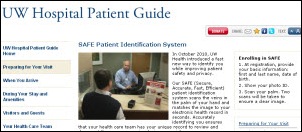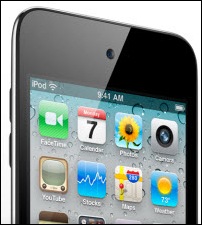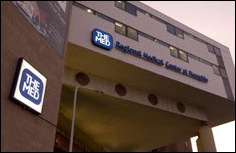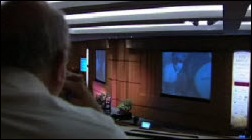Neither of those sound like good news for Oracle Health. After the lofty proclamations of the last couple years. still…
News 11/3/10
From Biometric Man: “Re: palm vein scan technology. It’s 100 times more accurate as a fingerprint and nearly impossible to hack. The scanner converts the subcutaneous vein pattern into thousands of zeroes and ones, all encrypted and behind the firewall. It’s then encrypted again to AES 128 bit. It’s useless for crime investigation since you can’t leave your vein pattern at a crime scene. Scanning helps prevent medical records overlays and merging, identify theft, lack of ID for unconscious patients, slow registration processes, and having someone overhear the patient’s Social Security Number or other private information when the clerk asks. UW Health has put up a patient guide to the technology, complete with video.”
From NoMoreCoffee: “Re: nancydoll’s rumor of GE Healthcare’s enterprise solution leader. Yes, absolutely true. A few other changes at that level, but no layoffs yet of technical people.”
From Duuude: “Re: Seattle Children’s. This is a good synopsis of what’s going on after the two medication error deaths.” I’ve been through the common post-error reactions of awareness meetings, mandatory training, and process redesign (usually of the quick-and-dirty variety) at my own hospitals. Unfortunately, (a) it happens only after someone dies from a mistake, and (b) going gung-ho after one kind of problem usually means it’s just a different one that harms the next patient. Technology is not usually to blame other than it fails to address the main issue: the lack of information at the place and time it’s needed. I can never figure out why hospitals don’t put up a portal for nurses, aides, and technicians that contains how-to videos, audio instructions, and links to resources. Lots of money is spent on technology to enter and deliver orders, but not much on actually executing those orders correctly. The processes that cause patient harm are usually on the sharp end of the stick: preparing drug doses, marking a surgical site, setting the correct radiation dose, or reacting to the patient monitors. I say this all the time but it’s good for the newbies to understand: HIT’s benefit isn’t how many errors it prevents, but rather how much harm it prevents. There’s a big difference. It’s not much consolation to prevent 90% of errors by number only to find that the incidence of patient harm hasn’t changed much because they stayed in the 10% (see: CPOE). If you implement a lot of technology without changing your outcomes, then you haven’t accomplished much (see: Most Wired).
From Remington: “Re: UCSF. Looks like the GE collapse wasn’t entirely their fault. The Epic team there is already hemorrhaging members due to a combination of inept UCSF employees and absurd out-of-scope demands.” Unverified. Epic usually controls those issues well.
I got the new iPod Touch, courtesy of Mrs. HIStalk, who knows that the way to this particular man’s heart is through his USB cable. Other than its crappy low-res camera, it’s amazing in every way: impossibly slim and light, FaceTime video calling, HD video recording, the super-fine Retina display, multitasking under the iPhone OS, great WiFi performance, long battery life, tons of apps (SMS messaging, Kindle reader, price comparison by barcode scan, etc.) I was telling Inga all the cool stuff I was doing with it when I realized there was one obvious omission considering that most people think of the iPod as a music player: I had yet to load or play even one MP3 (which is still the case since I’m streaming Pandora from it instead). Not many things can change your life for $219 and no recurring expense, but this is one of them. I’m taking it everywhere, maybe even to bed.
Anvita Health announces its patented application that creates personalized drug regimens using EMR data, comparative effectiveness, and the drug formulary.
If you haven’t made your HIMSS hotel reservations, better get on it. The HIMSS reservation system has good rates, which has been the case for the last 3-4 years (they were definitely not competitive before then). They guarantee the lowest price, which means nothing — you do your own legwork to find out you paid too much, take time to tell them about it, then they get to match the price they didn’t originally offer. I wanted a cheap place not far away and found a hotel I liked, but it was sold out on the HIMSS site. Not on the hotel’s own site, though – in fact, I got a AAA discount that made the price less than what HIMSS was quoting. If you want to be cheap like me (I’m at around $80 per night), you could also Priceline a room and maybe save money. I’ve done that – you can often take a taxi to/from each day and still save money, especially in Orlando where hotels are dirt cheap (and sometimes just plain dirty, so choose at least three stars on Priceline).
Speaking of HIMSS, it will be time to gear up here soon: the HISsies nominations and voting, preparations for our first-ever HIStalk sponsor lunch, and of course details on the big HIStalk bash on Monday night. I think we’ll have some new sponsors coming on board in time to ride that wave if history is a good indication, so thanks to the current sponsors who predated them in supporting Inga and me.
Listening: Horace Pinker, highly melodic, energetic, and smart pop-punk from Chicago. It’s a head-bobber for sure. I heard it on the iPod on HIStalk Radio, the Pandora station that adjusts the playlist as I give tunes thumbs up/down as they play. Others I liked: Metric, Arctic Monkeys, Death Cab for Cutie, and The Strokes.
Fujitsu releases the HOPE/EGMAIN-RX EMR for practices in Japan. It will cost around $25,000.
Michael Donner, former SVP/chief marketing officer of Eclipsys, is named VP of marketing at Tech Data.
Tech firms in India are calling the HIT spending “another Y2K opportunity,” but the Wall Street Journal observes that hospitals aren’t big on sending work offshore, most of the work isn’t the commodity programming work that usually gets sent overseas, and hospitals worry about privacy. It also notes that Indian companies are establishing offices here and offering to do work from either country, with lower prices for choosing offshore.
Industry longtimer Kerry de Vallette is named sales SVP of revenue cycle vendor SPi Healthcare.
Board members at Regional Medical Center (SC) argue over the $2 million needed to finish its Cerner implementation, with one trustee expressing surprise that the project doesn’t already meet Meaningful Use requirements that would allow the hospital to get $5 million in HITECH money. The CIO explained that the project was started in 2008 before the requirements were defined.
CapSite releases its revenue cycle management study. From the copy they sent me, it appears that hospitals are keeping their core patient accounting systems, but planning to add RCM components from other vendors and are budgeting money accordingly. Most interesting: of the top four strategic priorities for hospitals, two of them involve RCM.
The San Francisco Department of Health chooses eClinicalWorks for its 800 physicians.
Regional Medical Center at Memphis (TN) approves a $20 million capital budget for FY2011, with $6.3 million of that going toward its $21 million EMR project. That’s twice the amount the 418-bed hospital is budgeting for building maintenance. It’s the home of the Elvis Presley Memorial Trauma Center, which sounds strange to me.
Cerner will offer remote hosting in the UK in an agreement with Equinix.
Thomson Reuters launches Pharmacy Xpert, a clinical dashboard that uses real-time clinical surveillance information, patient information, and Micromedex content to help hospital pharmacists manage medication therapy. Pre-built profiles include monitoring of antimicrobials, anticoagulants, and hypoglycemic drugs, as well as IV-to-PO conversion and managing drugs with a narrow therapeutic index.
Cleveland Clinic’s eighth Medical Innovation Summit (to be more precise, it’s run by their Corporate Venturing Arm) started Monday afternoon and runs through Wednesday. Wednesday’s session on HIT includes David Brailer (Health Evolution Partners), Craig Feied (Microsoft), Martin Harris (Cleveland Clinic), Martin-J Sepulveda (IBM), and Vishal Wanchoo (GE Healthcare). If you like reading tweets more than I do, they’re here.
Several doctors in Australia are disciplined for ordering excessive lab tests, with one ordering 6,000 pathology tests for 771 patients. The director of the Professional Services Review watchdog that found the problem blames computers that make it too easy to order banks of tests without thinking.
The Hartford business paper profiles ProHealth, Connecticut’s largest physician group, and its $14 million technology investment. They see HIT as a key to success under healthcare reform, allowing providers to improve coordination, reduce duplicate work, and use outcome information to develop new programs.
The just-ended TEDMED conference in San Diego had some big-name speakers, among them Sanjay Gupta, David Blaine, Ozzy Osbourne, Tony Robbins, and Deepak Choprah. Among the attendees were Steve Wozniak, Martha Stewart, and Quincy Jones.
HERtalk by Inga
From Snoopy: “Re: my naivete. I have a confession. As a daily reader, I find it intriguing that your commentary, cadence, and wit are so closely tied to Mr. HIStalk’s. I’ve read Mr. HIStalk say that you are a real person with a custom cartoon-ized representation on these pages. Now for the naivete. How is it that you can circulate around conferences, interview executives, and still remain on the DL? Regardless, it’s a valuable contribution you and Mr. HIStalk (if you’re truly not the same peeps) make to the industry and having the ‘Practice’ part of HIStalk was a great and welcome addition that provides value to all who visit.” I can assure you that I am real and not a pathetic attempt by Mr. H to be in touch with his feminine side. I take it as a supreme compliment that my wit is comparable to Mr. H’s and appreciate the kind words about HIStalk Practice. Perhaps Mr. H and I have a similar cadence, but he wins the commentary award hands down. As for staying on the DL at conferences, I leave the fun shoes at home.
Eastern Maine Medical Center installs Dialog Medical’s iMedConsent application, which will interface to Millennium.
The Methodist Hospital (TX) and Dell Services launch a program to deploy NextGen EHR and PM at five hospitals in the Methodist system. Dell will provide hosting, training, and software support for the 289 physicians and staff that are part of the Methodist Hospital Physician Organization. Earlier this year, Methodist announced it would subsidized the purchase of NextGen for its affiliated physicians.
The Nuance Healthcare folks sent over this video that highlights the use of Dragon Medical. Apparently they shared it at a recent sales meeting and the crowd was howling.
Mediware Information Systems reports Q1 results: revenues of $12.5 million and net income of $1.1 million. That’s a 17% increase in revenues and 70% jump in income from last year.
TomoTherapy’s Hi-Art is the top-rated radiosurgery/radiation therapy product in KLAS’s new report on the radiation delivery market. Varian Clinac iX was the highest ranked oncology solution.
Holy Cross Hospital (NM) selects athenaClinicals and athenaCollector for its owned physician group of 40 providers. Holy Cross will also offer athenahealth’s services to affiliated community physicians.
Huron Consulting Group acquires Click Commerce, a provider of software solutions and professional services for academic medical centers and research institutions. Click Commerce president Nick Stier, COO Gary Raetz, and sales and marketing VP Gary Whitney will serve as a Huron managing directors. Terms were not disclosed.
Sponsor Updates
- Culbert Healthcare Solutions is now an Epic-certified consulting firm.
- SRS is listed again on the Inc 5000 List of Fastest Growing Private Companies.
- ACT Medical Group (NC) chooses NextGen’s PM/EHR for its 70 clinicians and 400 locations, including a telehealth service in which clinicians will work offline and sync data later.
- The Medical Society of Delaware signs with RelayHealth as a solution partner. The society will support technologies that connect patients to doctors, including sharing lab results via secure messaging and personal health records.
- NorthBay Healthcare (CA) picks Keane Patcom for its enterprise-wide revenue cycle management solution.

From the eClinicalWorks User Meeting in Orlando
By eCW Superuser
I arrived here on Saturday morning and got registered and checked-in easily. The pre-conference was, to my surprise, packed.
The Saturday evening reception in the exhibit hall was well attended. I was impressed by the size of the hall and the number of vendors exhibiting at the conference.
The keynote hall was massive and full, with 3,000+ attended the keynote (500 walk-ins included). It began with John Halamka discussing Meaningful Use and telling the crowd how to meet MU objectives. He was very complimentary of eCW referred to them as a moral company because, in his own experience, they cared more about their clients.
Girish presented the company overview and 2010 accomplishments. Sam Bhat ( co-founder) and Girish did an hour-long live product showcase of V9 with EBO 5 (real software, noy PowerPoint). Version 9.0 is not just an incremental step, but a whole new ball game. It incorporates modules for patient communication, interoperability, and mobile and text messaging into the EHR with On-Demand Activation (similar to apps for the iPhone or iPad). There’s a fancy patient portal called 100Millionpatients.com. With eCW P2P, you can send your referrals and charts from eCW to other providers even if they don’t use eCW (similar to NHIN Direct).
The fall festival happy was simply awesome. It was very family-friendly, yet the live band kept everyone hopping . I saw kids at 11 p.m.dancing. The Halloween costumes with face paintings and make-your-own crazy hat booth were fun.
Here are some other highlights:
- Customer Panels (primary care, Speciality care, eRX, Portal, interoperability for community records) were very informative.
- eCW employees are enthusiastic about their success and were very helpful at the conference.
- Sessions were well attended.
- eCW has a very excited customer base.
- Community record technology called eHX is being widely used by hospital clients











Another HIMSS housing idea. Check out http://www.vrbo.com. We’ve used it for several HIMSS. Always great deals and close to the convention centers. Only downside, no crowded hotel lobbies or elevators. You won’t see the entire HIMSS crowd as you come and go. And nothing under your door at night. But maybe after 12 hours of the convention that’s a good thing?
[From Mr. HIStalk] Great idea! I’ve used VRBO for vacations and it worked really well.
EPIC does not have a formal channel partner program and does not certify it’s consulting partners. Companies that claim to be EPIC certified consultants are making that designation up.
[From Mr. HIStalk] Epic lists on its Web page “Certified Consultants” that have been “approved by Epic for this listing”: http://www.epic.com/relationships-consultants.php
Mr HisTALK writes:
HIT’s benefit isn’t how many errors it prevents, but rather how much harm it prevents.
Excellent point. That bòn mót accurately reflects what I believe was the intent of the healthcare IT pioneers, who were primarily physicians.
If you implement a lot of technology without changing your outcomes, then you haven’t accomplished much
You have, but in a negative sense. You’ve expended resources that could have been used elsewhere, such as in better care for the poor, hiring more staff, or avoiding layoffs.
To Biometric man: The palm data itself may not be spoofable (though, since I’ve worked closely with such groups lately, I’m not so sure), but the underlying data base that associates the palm signature with an identity certainly can. So, once the palm signature is associated with the wrong identity, what then?
Remember when SSNs were safe and secure? The more biometrics are used, the more likely that they will go the way of SSNs in terms of identify liberation.